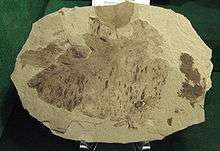Allenby Formation
| Allenby Formation Stratigraphic range: 52.5–48 Ma | |
|---|---|
| Type | Geological formation |
| Sub-units | Princeton Chert |
| Area | 300 km².[1] |
| Thickness | 1860-2100 m.[1] |
| Lithology | |
| Primary | Fluvial deposits |
| Other | shale–sandstone, coal–breccia, and coal–chert |
| Location | |
| Coordinates | 49°22.6′N 120°32.8′W / 49.3767°N 120.5467°WCoordinates: 49°22.6′N 120°32.8′W / 49.3767°N 120.5467°W |
| Region | British Columbia |
| Country | Canada |
| Type section | |
| Named for | Allenby, British Columbia (Shaw, 1952) |
See also: Princeton Chert
The Allenby formation is a sedimentary rock formation deposited during the early to early Middle Eocene. It consists of conglomerates, sandstones with interbedded with shales and coal. The coal seams contain an abundance of insect, fish and plant fossils, particularly in the Princeton Chert.[1]
The following fossil genera and species have been described from the Allenby formation:
- Acer rousei
- Acer stewarti
- Acer stonebergae
- Acer toradense
- Azolla primaeva
- Dinokanaga wilsoni
- Eriocampa tulameenensis
- Neviusia dunthornei
- Orontium wolfei
- Pseudosiobla campbelli
- Stonebergia[2]

Orontium wolfei is one example of many fossils that can be found in the Allenby formation.
References
- 1 2 3 Mustoe, G.E. (1 January 2011). "Cyclic sedimentation in the Eocene Allenby Formation of south-central British Columbia and the origin of the Princeton Chert fossil beds". Canadian Journal of Earth Sciences. 48 (1): 25–43. doi:10.1139/E10-085.
- ↑ Wolfe, J.A.; Wehr, W.C. (1988). "Rosaceous Chamaebatiaria-like foliage from the Paleogene of western North America". Aliso. 12 (1): 177–200.
This article is issued from Wikipedia - version of the 8/24/2016. The text is available under the Creative Commons Attribution/Share Alike but additional terms may apply for the media files.